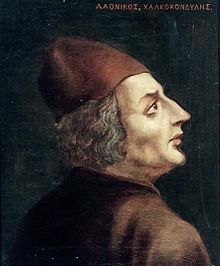- Laonikos Chalkokondyles
-
Laonikos Chalkokondyles, latinized as Laonicus Chalcondyles (Greek: Λαόνικος Χαλκοκονδύλης, from λαός "people", νικᾶν "to be victorious", an anagram of Nikolaos which bears the same meaning; c. 1423 – 1490) was a Byzantine Greek scholar from Athens.
Contents
Life
He was a Byzantine historian, son of George and cousin of Demetrios Chalcocondylas. After a quarrel between his father and the Florentine dukes of Athens, he followed his family to the Peloponnese where, according to Kyriakos the Agonites, he lived in the court of Constantine Palaiologos and was taught by George Gemistos Plethon.
After the destruction of Constantinople, he wrote his most important historical work, Proofs of Histories (Ἀποδείξεις Ἱστοριῶν) (10 books). This historical work of Laonikos Chalkokondyles comprises one of the most important sources for the students of the final 150 years of Byzantine history. It covers the period from 1298–1463, describing the fall of the Greek empire and the rise of the Ottoman Turks, which forms the centre of the narrative, down to the conquest of the Venetians and Mathias, king of Hungary, by Mehmed II. The capture of Constantinople he rightly regarded as an historical event of far-reaching importance and compared it to the fall of Troy. Like that of other Byzantine writers, his chronology is defective. The work also sketches other manners and civilization of England, France and Germany, whose assistance the Greeks sought to obtain against the Turks. For his account of earlier events he was able to obtain information from his father.
His model is Thucydides (according to Bekker, Herodotus), his language is tolerably pure and correct, and his style is simple and clear. The text, however, is in a very corrupt state. The archaic language he used made his texts hard to read in many parts, while the antiquarian names, with which he named people of his time, created confusion (Γέται, Δάκες, Λίγυρες, Μυσοί, Παίονες etc). The extended use of the named 'Hellenes' (Ἕλληνες), which Laonikos used to describe the Byzantines contributed to the connection made between the ancient Greek civilization and the modern one.
Serbs
Chalkokondyles wrote that the Serbs are "the greatest and oldest people on Earth", noting that they are the autochtonous population of the Balkans and identified them with groups such as Illyrians. His work is the basis of the revisionist autochtonist Serbian historical school.
See also
- Chalkokondyles
- Byzantine scholars in Renaissance
References
- The Historical work of Laonicus Chalcocondyles was first published in 1615 by J. B. Baumbach.
- The two best editions are: Historiarum Libri Decem, ed. I. Bekker, Corpus Scriptorum Historiae Byzantinae (Bonn 1843) and Historiae Demonstrationes, 2 vols., ed. E. Darko, (Budapest 1922-7). The text can also be found in J.-P. Migne, Patrologia Graeca, volume 159.
- A French translation was published by Blaise de Vigenère in 1577 with a later edition by Artus Thomas, with valuable illustrations on Turkish matters.
- An English translation of Books I-III can be found in Laonikos Chalkokondyles. A Translation and Commentary of the Demonstrations of Histories, trans. Nikolaos Nikoloudis (Athens 1996) and of Book VIII in J. R. Melville Jones, The Siege of Constantinople: Seven Contemporary Accounts (Amsterdam 1972), pp. 42–55.
- There is a biographical sketch of Laonicus and his brother, Demetrius Chalcondyles in Greek by Antonius Calosynas, a physician of Toledo, who lived in the latter part of the sixteenth century: see in C. Hopf, Chroniques Gréco-romanes (Paris 1873), pp. 243–5.
- In The Great Warrior Skanderbeg, Laonicus Chalcocondyles is portrayed as an official historian at the Ottoman Court with opportunistic views on politics who tries to discourage Skanderbeg from an anti-Ottoman insurrection. After Skanderbeg leaves the Ottoman army and becomes leader of Albania on his own right, Chalcocondyles is brought as a hostage to his court to witness the First Siege of Krujë.
Further reading
- E. Darko, 'Zum Leben Laonikos Chalkondyles', Byzantinische Zeitschrift 24 (1923-4) 29-39.
- Jonathan Harris, ‘Laonikos Chalkokondyles and the rise of the Ottoman Empire’, Byzantine and Modern Greek Studies 27 (2003), 153-70.
- Karl Krumbacher, Geschichte der byzantinischen Litteratur (Berlin, 1897).
- William Miller, 'The last Athenian historian', Journal of Hellenic Studies 42 (1922), 36-49.
- Nikolaos Nikoloudis, 'Laonikos Chalkokondyles on the Council of Florence', Ekklesiastikos Pharos 3 (1992) 132-4.
- Speros Vryonis, ‘Laonikos Chalkokondyles and the Ottoman budget’, International Journal of Middle East Studies 7 (1976), 423-32, and reprinted in Vryonis, Studies on Byzantium, Seljuks and Ottomans, No. XII.
 This article incorporates text from a publication now in the public domain: Chisholm, Hugh, ed (1911). Encyclopædia Britannica (11th ed.). Cambridge University Press.
This article incorporates text from a publication now in the public domain: Chisholm, Hugh, ed (1911). Encyclopædia Britannica (11th ed.). Cambridge University Press.
External links
Categories:- 1420s births
- 1490 deaths
- People from Athens
- Byzantine historians
- Greek Renaissance humanists
- 15th-century Byzantine people
- 15th-century historians
- Byzantine Athenians
- 15th-century Greek people
- Chalkokondyles family
Wikimedia Foundation. 2010.

